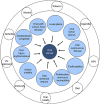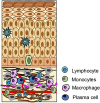Oral Potentially Malignant Disorders: Etiology, Pathogenesis, and Transformation Into Oral Cancer
- PMID: 35517828
- PMCID: PMC9065478
- DOI: 10.3389/fphar.2022.825266
Oral Potentially Malignant Disorders: Etiology, Pathogenesis, and Transformation Into Oral Cancer
Abstract
Among oral diseases, oral cancer is a critical health issue due to its life-threatening potential. Globocan, in its 2020 report, estimated ∼0.37 million new cases of oral cancer, with the majority of them coming from the Asian continent. The WHO has anticipated a rise in the incidences of oral cancer in the coming decades. Various factors, such as genetic, epigenetic, microbial, habitual, and lifestyle factors, are closely associated with oral cancer occurrence and progression. Oral lesions, inherited genetic mutations (dyskeratosis congenital syndrome), and viral infections (HPV) are early signs of oral cancer. Lesions with dysplastic features have been categorized under oral potentially malignant disorders (OPMDs), such as oral leukoplakia, erythroplakia, oral submucous fibrosis (OSMF), and proliferative verrucous leukoplakia, are assumed to have a high risk of malignancy. The incidence and prevalence of OPMDs are recorded as being high in South-Asian countries. Early detection, prevention, and treatment of OPMDs are needed to prevent its malignant transformation into oral cancer. Many advanced diagnostic techniques are used to predict their progression and to assess the risk of malignant transformation. This communication provides insight into the importance of early detection and prevention of OPMDs.
Keywords: erythroplakia; leukoplakia; malignant transformation; oral lichen planus; oral lichenoid lesions; oral potentially malignant disorders; oral submucous fibrosis; proliferative verrucous leukoplakia.
Copyright © 2022 Kumari, Debta and Dixit.
Conflict of interest statement
The authors declare that the research was conducted in the absence of any commercial or financial relationships that could be construed as a potential conflict of interest.
Figures













References
-
- Abidullah M., G K. K., Mawardi H., Alyami Y., Arif S. M., Qureshi Y. (2018). Clinical and Histopathological Correlation of Oral Submucous Fibrosis- an Institutional Study. jemds 7 (18), 2227–2230. 10.14260/jemds/2018/501 - DOI
Publication types
LinkOut - more resources
Full Text Sources

